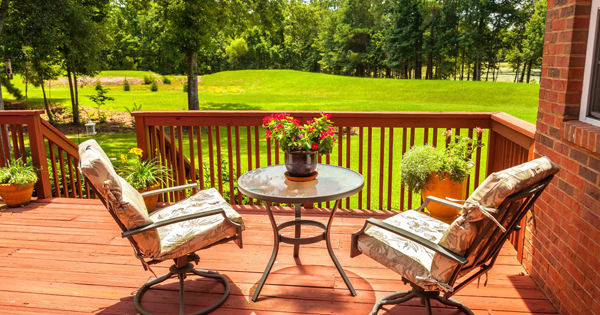1. Where your garden gets the sun at different times of the day could make a big difference to how much you’ll use your new deck or patio. The usual place to put it is near the house, so it’s convenient for alfresco dining and entertaining, but there might be a better spot elsewhere. While most of us want a sunny deck or patio, some people prefer one with shade, which might mean putting it at the opposite end of the garden to the house.
2. When deciding on the location of your patio or deck, think about things like drainage (the manhole, or at least a rodding point, still needs to be accessible), where the doors to the garden are, and if the patio or deck will be overlooked. Also consider the prevailing winds, traffic noise, if any, and what you’ll be looking out on when you sit and relax.
3. Decking is a good way to make sloping gardens usable, as an alternative to creating tiers. By extending the deck out from the house to cover the whole garden, you’ve solved the problem of an awkward, hard-to-use and even potentially dangerous (if you have small children) outside space. Decking can also be the best way to cover something that’s already there, such as concrete or a dated patio, because you can go over the top of it. With small, courtyard gardens, decking or paving the whole space makes sense if they’re too small for a lawn.
4. It’s important to have a patio or deck that’s in proportion to the size of the house, and to use colours and materials that work well with the building, unless you want a deliberate contrast. While it should be in keeping, your design can also be creative. Decking can be built on different levels, with things like built-in benches and planters that make it more practical and interesting. You can do a similar thing with paving – an easy way to add interest is to incorporate a circle or other design into your patio using a paving kit.
5. Before you start building your patio or deck, check if any permissions are required. If your home’s leasehold, for example, you may need the freeholder’s consent and also planning permission because flats and maisonettes don’t have permitted development rights. You should always seek expert advice about what you are and aren’t allowed to do with your property before spending money on materials.
How-to tip
Garden wood, such as fencing and sheds, often comes pre-treated, but some pre-treatments make the wood so orange that covering it with a nicer colour isn’t easy. Applying pale garden-wood paint, such as cream, can even turn the wood pink – several coats are usually necessary for it to get near cream. Do a tester patch and if this is the case, consider switching to a stronger colour that will cover in fewer coats. Alternatively, use a pale exterior wood paint, – this covers extremely orange garden wood in two or three coats.
newsletter.html”]
